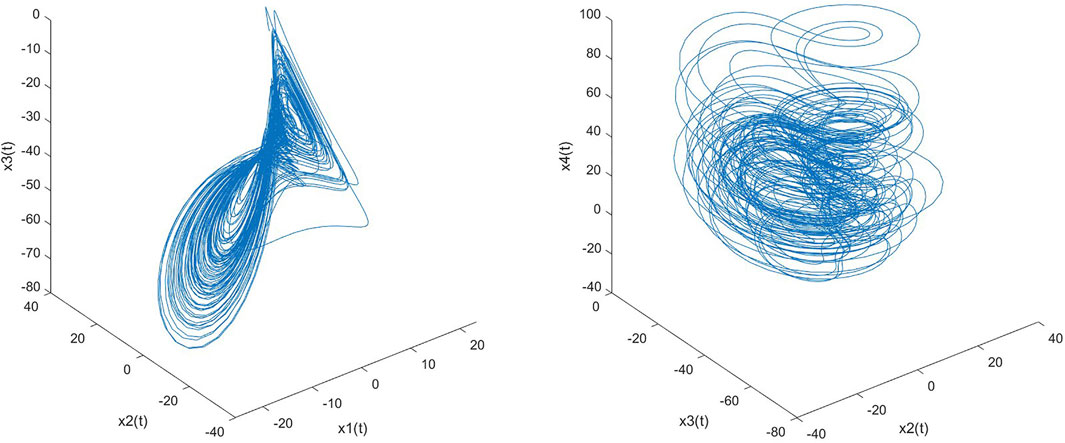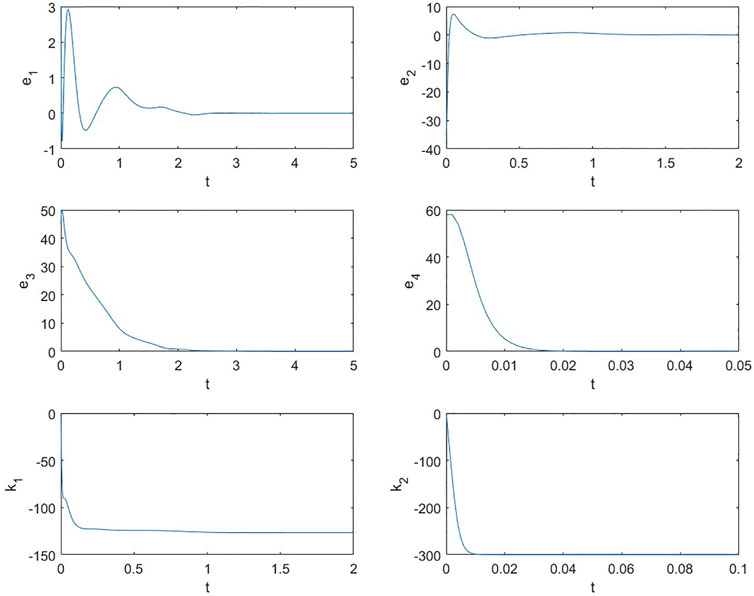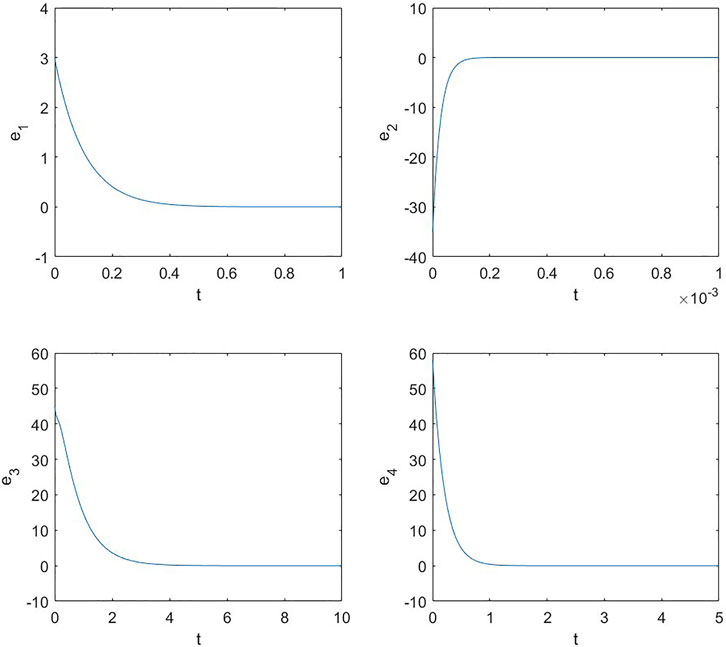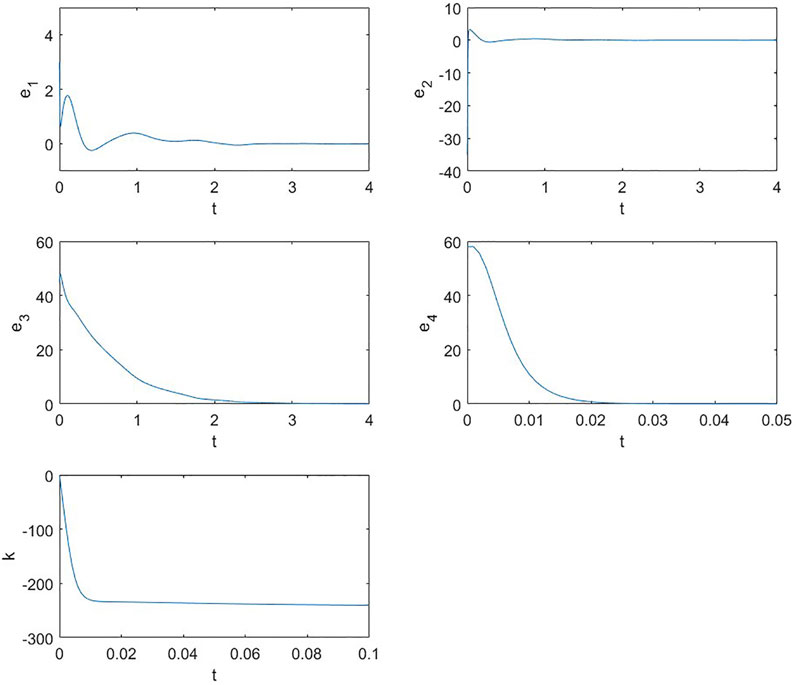- 1School of Mathematics and Statistics, Nanjing University of Information Science and Technology, Nanjing, China
- 2INRIA Lille-Nord Europe, Villeneuve d’Ascq, France
In this paper, the adaptive control design is investigated for the chaos synchronization of two identical hyperchaotic Liu systems. First, an adaptive control law with two inputs is proposed based on Lyapunov stability theory. Secondly, two other control schemes are obtained based on a further analysis of the proposed adaptive control law. Finally, numerical simulations are presented to validate the effectiveness and correctness of these results.
1 Introduction
Since it was introduced by Pecora and Carroll [1] in 1990, the synchronization of chaotic systems has attracted increasing attention due to its possible applications in secure communication [2–4], biomedical Engineering [5], information science [6], chemical reactions [7, 8], etc. Then a wide variety of control methods of chaos synchronization have been studied such as the linear feedback control [9, 10], the sliding mode control [11], the adaptive control [12–16], the backstepping control [17, 18] and so on.
A hyperchaotic system is a chaotic system with at least two positive Lyapunov exponents which improves the security by generating more complex dynamics and so hyperchaotic systems have much more applications than low-dimension chaotic systems in the areas such as secure communication and image encryption, etc. Therefore in the past three decades, an increasing interest has been devoted to the study of chaos synchronization for hyperchaotic systems and plenty of research works can be found in literature [13, 19–25]. However, there are few studies about the adaptive synchronization of hyperchaotic Liu system that was introduced in [26]. A difficulty for this problem is that it is not evident to construct a suitable Lyapunov function to prove the stability of the error dynamics because of the special complex structure of hyperchaotic Liu system, since such a Lyapunov function depends on how to choose the feedback gain of controller in the slave system. Regarding those gains as unknown parameters, the use of adaptive control concept to estimate those unknown gains may be helpful to solve this problem. Therefore, this paper investigates the adaptive control design for the synchronization of hyperchaotic Liu system. First, an adaptive control law with two inputs is proposed and moreover, by introducing a suitable Lyapunov function, the main result is proved based on Lyapunov stability theory and Barbalat’s lemma. In addition, two special cases of this adaptive control scheme is further analyzed so that two other control laws are derived for the synchronization of hyperchaotic Liu system.
This paper is organized as follows. Section 2 formulates the problem. In Section 3, an adaptive control law for the synchronization of hyperchaotic Liu systems is proposed. In Section 4, two other control laws are derived based on further analysis of the proposed adaptive control law. Numerical simulations are given in Section 5. We conclude this paper in Section 6.
2 System Description and Problem Formulation
2.1 System Description
The hyperchaotic Liu system was proposed firstly in [26] and can be described by the following differential equations
where a, b, c, d are positive real constants and
2.2 Problem Formulation
Let system (Eq. 1) be the master system and the corresponding slave system is described by the following equations:
where
It is evident that the synchronization between (Eqs 1, 2) can be easily achieved if we can use all measurements xi of (Eq. 1) to active all controller ui in (Eq. 2). But the interesting question is: can we use less information of (Eq. 1) to active only some of the controllers ui in (Eq. 2)? The positive answer of this question will be more applausive since less sensors are needed for (Eq. 1) to measure only the necessary states, and less energy will be consumed to actuate some necessary ui in (Eq. 2). Consequently, the purpose of this paper is, by using less measurement from (Eq. 1) and activating less actuator for (Eq. 2), to design an adaptive control scheme in order to achieve global chaos synchronization of two identical hyperchaotic Liu systems, i.e., for any initial conditions y(0) ≠ x(0), we have
where
3 Adaptive Synchronization of Hyperchaotic Liu System
In the following, we will present our result by activating only two controllers (u2 and u4) in (Eq. 2) with only two measurements (x2 and x4) of (Eq. 1) to solve the global synchronization problem.
Theorem 3.1. The master system (Eq. 1) and the slave system (Eq. 2) can be global synchronized by the following controllers
where k1 and k2 denote the feedback gains which are updated by the following adaptive laws
with γ1 and γ2 being arbitrary positive constants.
Proof. Under the adaptive control laws (Eqs 4, 5), the error dynamics (Eq. 3) reads
Consider the following Lyapunov function
where L1, L2 and ρ are positive constants which will be determined later. Calculating the differentiation of (Eq. 7) with respect to time t along trajectories of system (Eq. 6), we obtain
where
Clearly, if the symmetric matrix P1 is positive definite, then we have
From the condition Δk > 0, for 1 ≤ k ≤ 4, and (Eq. 10), it is easy to obtain
Therefore, there always exist positive L1, L2 and ρ satisfying the above conditions so that
Remark 3.1. In the Lyapunov function (Eq. 7), a positive constant ρ has to be introduced to guarantee the positive definite of the symmetric matrix P1.
Remark 3.2. The feedback gains k1 and k2 will converge to two constants
4 Further Analysis of Theorem 3.1
In Theorem 3.1, the feedback gains k1 and k2 are defined to be updated by the adaptive laws (Eq. 5), i.e.,
where γ1 and γ2 are arbitrary positive constants. Two interesting questions arise:
• If γ1 = γ2 = 0 that implies
• If the feedback gains k1 and k2 are equal (for the sake of implementation simplicity), i.e., k1 = k2, how to modify the adaptive law (Eq. 5) such that the chaos synchronization can still be achieved?
In the following, we will answer the above two questions and derive two other special control laws for the chaos synchronization of hyperchaotic Liu system.
4.1 Case 1: k1 and k2 Are Constants
Proposition 4.1. The master system (Eq. 1) and the slave system (Eq. 2) can be global synchronized by the following linear feedback controller
where the feedback gains k1, k2 satisfy
with
Proof. The proof of the above result is quite similar to that of Theorem 3.1. Consider the following Lyapunov function
where ρ is a positive constant which will be determined later. Taking the differentiation of (Eq. 14) with respect to time t and following the similar procedure in the proof of Theorem 3.1, we obtain
where
It is easy to see that the symmetric matrix P2 has the same structure with P1, given by (Eq. 9), and the only difference is that L1 and L2 are replaced by −k1 and −k2, respectively. Therefore, by a similar procedure of the proof of Theorem 3.1, we can obtain that P2 is positive definite if and only if the following conditions are satisfied
Therefore, there always exist k1, k2 and ρ satisfying the above conditions so that
4.2 Case 2: k1 and k2 Are Equal
Proposition 4.2. The master system (Eq. 1) and the slave system (Eq. 2) can be synchronized by the following adaptive controller
where k denotes the feedback gain which is updated by the following adaptive law
with γ being an arbitrary positive constant.
Proof. Following the same procedure as that in the proof of Theorem 3.1, by considering the following Lyapunov function
where ρ and L are positive constants which will be determined later, we obtain
with
Clearly, the symmetric matrix P3 has the same structure with P1, given by (Eq. 9), in which L1 = L2 = L. Thus, by a similar procedure of the proof of Theorem 3.1, we can obtain that P3 is positive definite if and only if the following conditions are satisfied
The rest of the proof is exactly the same as that in the proof of Theorem 3.1.
5 Numerical Simulations
In this section, numerical simulations by MATLAB will be given to validate the correctness and effectiveness of the proposed controller designs. Fourth order Runge-Kutta method is applied to approximate the solution of differential equations with a small chosen fixed time step size. The system parameters are set to a = 10, b = 35, c = 1.4, d = 5 so that the Hyperchaotic Liu system exhibits chaotic behavior when no control is applied.
In order to compare the three control laws proposed in Theorem 3.1, Proposition 4.1 and Proposition 4.2, we will use the same initial conditions x(0) and y(0) for all the three numerical simulations. The initial conditions of the master system are chosen as x1(0) = 15, x2(0) = 22, x3(0) = −46 and x4(0) = −21 while the initial conditions of the slave system are chosen as y1(0) = 18, y2(0) = −13, y3(0) = −1 and y4(0) = 37.
First, consider the adaptive control law (Eq. 4) associated with (Eq. 5) proposed in Theorem 3.1 and select γ1 = 10, γ2 = 20 and the initial conditions of the feedback gain by k1(0) = k2(0) = 1. Figure 2 shows that the error states are asymptotically stable to zero while the control gains k1 and k2 tend to two negative constants, respectively, as t tends to infinity.
Second, consider the control law proposed in Proposition 4.2 and select upper bounds of M2 and M3 by M2 = 52, M3 = 82 (according to the bounded simulation results depicted in Figure 1). From conditions (Eqs 12, 13), a direct calculation gives that k1 < −30 097 and k2 < −3 and we choose k1 = −31 000 and k2 = −5. Figure 3 shows that the error states asymptotically converge to zero, as t tends to infinity.
Finally, consider the adaptive control law (Eq. 17) associated with (Eq. 18) proposed in Theorem 3.1 and select γ = 10 and k(0) = 1. Figure 4 shows that the error system is asymptotically stable to zero and the control gain k tends to a negative constant as t tends to infinity.
6 Conclusion
This paper has addressed the adaptive synchronization problems of hyperchaotic Liu systems. An adaptive control scheme has been proposed for the asymptotically synchronization of two identical hyperchaotic Liu systems. This result was proved according to Lyapunov stability theory and Barbalat’s lemma by constructing a suitable Lyapunov function. Moreover, through further discussions of the main result, two other control schemes have been derived. The numerical simulations verify the effectiveness and correctness of the control laws proposed in this work.
Data Availability Statement
The original contributions presented in the study are included in the article/Supplementary Material, further inquiries can be directed to the corresponding author.
Author Contributions
SL: Conceptualization, Methodology, Project administration, Funding acquisition. YW: Validation, Investigation, Writing–Original Draft. GZ: Supervision, Writing–Review and Editing.
Funding
This work is supported by the Natural Science Foundation of China (No. 61573192).
Conflict of Interest
The authors declare that the research was conducted in the absence of any commercial or financial relationships that could be construed as a potential conflict of interest.
Publisher’s Note
All claims expressed in this article are solely those of the authors and do not necessarily represent those of their affiliated organizations, or those of the publisher, the editors and the reviewers. Any product that may be evaluated in this article, or claim that may be made by its manufacturer, is not guaranteed or endorsed by the publisher.
References
1. Pecora LM, Carroll TL. Synchronization in Chaotic Systems. Controlling Chaos (1996) 6:142–5. doi:10.1016/b978-012396840-1/50040-0
2. Liao T-L, Tsai S-H. Adaptive Synchronization of Chaotic Systems and its Application to Secure Communications. Chaos, Solitons & Fractals (2000) 11:1387–96. doi:10.1016/s0960-0779(99)00051-x
3. Zheng G, Boutat D, Floquet T, Barbot J-P. Secure Data Transmission Based on Multi-Input Multi-Output Delayed Chaotic System. Int J Bifurcation Chaos (2008) 18:2063–72. doi:10.1142/s0218127408021567
4. Hoang TM. A New Secure Communication Model Based on Synchronization of Coupled Multidelay Feedback Systems. Int J Electronics Commun Eng (2010) 4:491–7. doi:10.5281/zenodo.1329807
5. Vuksanović V, Gal V. Nonlinear and Chaos Characteristics of Heart Period Time Series: Healthy Aging and Postural Change. Auton Neurosci (2005) 121:94–100. doi:10.1016/j.autneu.2005.06.004
6. Wang L, Dong T, Ge M-F. Finite-Time Synchronization of Memristor Chaotic Systems and its Application in Image Encryption. Appl Mathematics Comput (2019) 347:293–305. doi:10.1016/j.amc.2018.11.017
7. Vaidyanathan S. Anti-synchronization of Brusselator Chemical Reaction Systems via Adaptive Control. Int J ChemTech Res (2015) 8:759–68.
8. Li Y-N, Chen L, Cai Z-S, Zhao X-z. Experimental Study of Chaos Synchronization in the Belousov-Zhabotinsky Chemical System. Chaos, Solitons & Fractals (2004) 22:767–71. doi:10.1016/j.chaos.2004.03.023
9. Yassen MT. Controlling Chaos and Synchronization for New Chaotic System Using Linear Feedback Control. Chaos, Solitons & Fractals (2005) 26:913–20. doi:10.1016/j.chaos.2005.01.047
10. Huijberts H, Nijmeijer H. Nonlinear Chaos Control and Synchronization (Handbook of Chaos Control). 2nd ed. (2007) Weinheim, Germany: WILET-VCH Verlag GmbH & Co. KGaA.
11. Yau H-T. Design of Adaptive Sliding Mode Controller for Chaos Synchronization with Uncertainties. Chaos, Solitons & Fractals (2004) 22:341–7. doi:10.1016/j.chaos.2004.02.004
12. Wang Y, Guan Z-H, Wang HO. Feedback and Adaptive Control for the Synchronization of Chen System via a Single Variable. Phys Lett A (2003) 312:34–40. doi:10.1016/s0375-9601(03)00573-5
13. Wang X, Wang Y. Adaptive Control for Synchronization of a Four-Dimensional Chaotic System via a Single Variable. Nonlinear Dyn (2011) 65:311–6. doi:10.1007/s11071-010-9893-1
14. Rasappan S, Kumar Jothi N, Kumar Kumaravel S. Control of Colpitts-Oscillator via Adaptive Feedback Control. Malaysian J Math Sci (2016) 10:46–60.
15. Wu J, Ma Rr. Robust Adaptive Finite‐Time and Fixed‐time Synchronization of Chaotic Systems With Smooth Control. Int J Robust Nonlinear Control (2021) 31:8974–88. doi:10.1002/rnc.5750
16. Li S-J, Wu Y-W, Zheng G. Adaptive Synchronization of Chaotic Systems With Less Measurement and Actuation. Chin Phys. B (2021) 30:100503. doi:10.1088/1674-1056/abec33
17. Wang C, Ge SS. Synchronization of Two Uncertain Chaotic Systems via Adaptive Backstepping. Int J Bifurcation Chaos (2001) 11:1743–51. doi:10.1142/s0218127401002985
18. Bowong S, Moukam Kakmeni FM. Synchronization of Uncertain Chaotic Systems via Backstepping Approach. Chaos, Solitons & Fractals (2004) 21:999–1011. doi:10.1016/j.chaos.2003.12.084
19. Zheng G, Boutat D. Synchronisation of Chaotic Systems via Reduced Observers. IET Control Theor Appl (2011) 5:308–14. doi:10.1049/iet-cta.2010.0078
20. Elabbasy EM, Agiza HN, El-Dessoky MM. Adaptive Synchronization of a Hyperchaotic System With Uncertain Parameter. Chaos, Solitons & Fractals (2006) 30:1133–42. doi:10.1016/j.chaos.2005.09.047
21. Qiang J. Adaptive Control and Synchronization of a New Hyperchaotic System With Unknown Parameters. Phys Lett A (2007) 362:424–9. doi:10.1016/j.physleta.2006.10.044
22. Cai G, Zheng S, Tian L. Adaptive Control and Synchronization of an Uncertain New Hyperchaotic Lorenz System. Chin Phys B (2008) 17:2412–9. doi:10.1088/1674-1056/17/7/014
23. Yu S-H, Hyun C-H, Park M-N. Backstepping Control and Synchronization for 4-d Lorenz-Stenflo Chaotic System With Single Input. Int J Fuzzy Logic Intell Syst (2011) 11:143–8. doi:10.5391/ijfis.2011.11.3.143
24. Vaidyanathan S. Analysis, Control and Synchronization of Hyperchaotic Zhou System via Adaptive Control. (Eds) Meghanathan N., Nagamalai D., Chaki N. Advances in Computing and Information Technology. Advances in Intelligent Systems and Computing, 177. Springer Berlin Heidelberg (2013). doi:10.1007/978-3-642-31552-7_1
25. Rasappan S, Niranjan Kumar K. Dynamics, Control, Stability, Diffusion and Synchronization of Modified Chaotic Colpitts Oscillator. Arch Control Sci (2021) 31:731–59. doi:10.24425/acs.2021.138699
Keywords: chaos synchronization, hyperchaotic liu system, adaptive control, barlalat’s lemma, lyapunov stability theory
Citation: Li S, Wu Y and Zheng G (2022) Adaptive Synchronization for Hyperchaotic Liu System. Front. Phys. 9:812048. doi: 10.3389/fphy.2021.812048
Received: 09 November 2021; Accepted: 22 November 2021;
Published: 03 January 2022.
Edited by:
Abdelaziz Soufyane, University of Sharjah, United Arab EmiratesReviewed by:
Rasappan Suresh, University of Technology and Applied Sciences, OmanXiaotai Wu, Anhui Polytechnic University, China
Copyright © 2022 Li, Wu and Zheng. This is an open-access article distributed under the terms of the Creative Commons Attribution License (CC BY). The use, distribution or reproduction in other forums is permitted, provided the original author(s) and the copyright owner(s) are credited and that the original publication in this journal is cited, in accordance with accepted academic practice. No use, distribution or reproduction is permitted which does not comply with these terms.
*Correspondence: Shunjie Li, c2h1bmppZS5saUBudWlzdC5lZHUuY24=
 Shunjie Li
Shunjie Li Yawen Wu
Yawen Wu Gang Zheng2
Gang Zheng2


